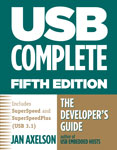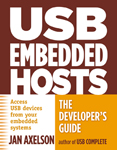Home > USB Central
USB Central
For developers of USB devices, firmware, hosts, and host software.
Topics on this page
News | Books | USB-IF | USB 3.0/3.1 | USB 2.0 | Power | Wireless USB | More information sources | For end users
More USB pages
Chips | Device code | Development tools | Device hardware | HIDs | Host software | Mass storage | OTG and embedded hosts | WinUSB
News
USB Complete Fifth Edition is available now!
Books
USB Complete: The Developer's Guide, Fifth Edition
USB Mass Storage: Designing and Programming Devices and Embedded Hosts
Serial Port Complete: COM Ports, USB Virtual COM Ports, and Ports for Embedded Systems
USB Embeddded Hosts: The Developer's Guide
USB-IF
The USB-IF is the non-profit organization that sponsors the USB specifications and provides support for developers.
The USB-IF Developers Discussion Forum no longer exists. An alternative is my PORTS forum.
USB 3.0/3.1
USB 3.1, released on July 26, 2013, adds the SuperSpeedPlus interface with a bus speed of 10 Gbps and also supports SuperSpeed at 5 Gbps. This specification replaces the USB 3.0 specification.
USB 3.1 vs USB 3.0: Technical Comparison. From Aditya Mittal and Rahul Kumar at Arrow Devices.
SuperSpeed Extends USB (short introduction to SuperSpeed)
USB 3.0 PHY interface and xHCI (eXtensible Host Controller Interface) host controller specifications.
USB 2.0
The USB 2.0 specification supports bus speeds of 480 Mbps (high speed, also called Hi Speed), 12 Mbps (full speed), and 1.5 Mbps (low speed). Note that USB 2.0 does not mean "high speed." A USB 2.0 device can be any speed. An ECN to the USB 2.0 specification adds a new descriptor type for composite devices: the interface association descriptor (IAD).
As of May, 2007, the Mini-A and Mini-AB connectors have been deprecated in favor of the Micro-A and Micro-AB.
The USB Implementer's Forum's Hi-Speed USB page.
My article Inside USB 2.0: What the New Spec Means for Developers (EDN).
Transceivers
USB 2.0 Transceiver Macrocell Interface (UTMI) specification. From Intel.
The ULPI (UTMI + Low Pin Interface) specification describes an interface that reduces the pin count for discrete USB transceiver implementations.
Power
The USB Power Delivery (PD) specification defines hardware and protocols that allow bus currents as high as 5A, VBUS voltages up to 20V, more precise power management, and even the ability to reverse the flow of current so a device can provide power to a host.
PoweredUSB enables USB devices to draw more than 500mA from the cable. Targeted at point-of-sale (POS) applications. Requires a license from IBM.
Wireless USB
Options for wireless USB communications.
Media Agnostic USB
The USB-IF's Media Agnostic (MA) USB specification enables using USB drivers to communicate over a variety of wireless and wired interfaces.
The first use for MA USB will be 1-Gbps wireless communications based on the WiGig Serial Extension (WSE) v1.2 specification from the Wi-Fi Alliance. The Wi-Fi Alliance transferred the WSE specification to the USB-IF for use in MA USB. WiGig uses unlicensed 60-GHz frequencies for short-range communications.
Wireless USB (formerly Certified Wireless USB)
The USB-IF's Wireless USB Promoter Group has developed a wireless USB (WUSB) specification for communicating at up to 480 Mbps.
Challenges of Migrating to Wireless USB. From Ellisys.
Understanding the Impact of Encryption on Certified Wireless USB Testing. From LeCroy.
Wireless USB FAQ. From Everything USB.
WirelessUSB
Cypress's WirelessUSB system uses a 2.4-Ghz wireless connection and enables implementing wireless devices that function as low-speed USB devices. Not recommended for new products.
More information sources
Articles, books, classes, and more.
Articles
Articles by Jan Axelson
More articles
USB Made Simple. A series of articles from MQP Electronics.
Stealing USB Port Power. How to design bus-powered devices. Robert Kollman and John Betten, EDN.
Circuit Cellar has published dozens of USB-related articles including some of mine. Back issues are available in print, on CD, and as individual article downloads.
Books
Books by Jan Axelson
More books
USB 3.0 Technology: Comprehensive Guide to SuperSpeed USB. The USB 3.0 specification in depth.
USB: The Universal Serial Bus. Low-level programming of host controllers.
Universal Serial Bus System Architecture, Second Edition. Inside the USB 2.0 specification.
USB Design by Example, Second Edition. With projects. Author website.
Developing Drivers with the Windows Driver Foundation. Windows drivers for devices that can't use an existing driver.
Classes
USB System Architecture Class. From Mindshare.
TV
Intel commercial about Ajay Bhatt, co-creator of USB.
For end users
Information on finding USB products and getting them to work.
Finding products
USBStuff has USB products from many vendors.
B+B SmartWorx has a good selection of USB converters, cables, and hubs.
USConverters has many USB converters.
Help in getting peripherals working
The USB Implementers Forum has an FAQ that answers many user questions.
Unable to Print from Command Prompt or MS-DOS Program with USB Printer From Microsoft. Article ID 259939.




